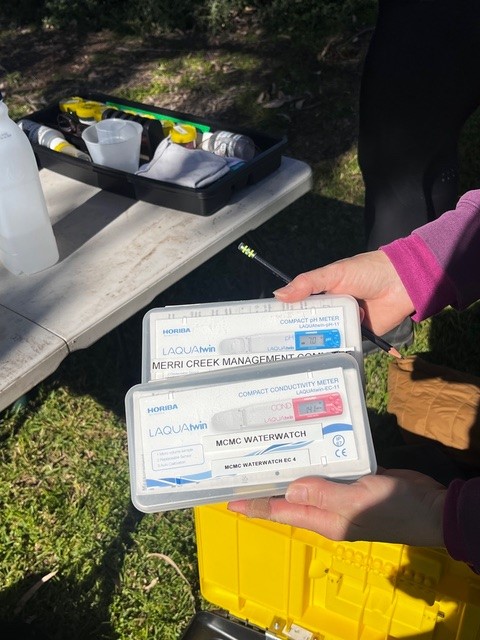WaterWatch in Melbourne: interview with volunteer Siqing
Karen
May 16, 2025, noon

Siqing Yu is a PhD student at the KU Leuven (Belgium) and the University of Melbourne (Australia). As part of her PhD, she has been researching a wide range of citizen science projects. As her ethnographic fieldwork, she took part a few times as a volunteer in the WaterWatch project in the area of Melbourne, facilitated by the Merri Creek Management Committee, a local not-for-profit environmental organization. In this interview, she tells us more about this Australian project measuring water quality, how it came to be and challenges it faced.
When did the Merri Creek WaterWatch project start?
Siqing: The project operates under the broader WaterWatch Victoria program, which commenced in 1993 to promote citizen science and environmental stewardship across the state. Their long-standing members started from a pre-existing environmental activist group that were advocating for green public spaces and environmental friendly urban projects since 1989, the Friends of Merri Creek. Merri Creek Management Committee (MCMC) is the main mediating body providing training, equipment, and guidance to volunteers, enabling them to assess water quality and contribute valuable data for the creek's conservation.
MCMC works closely with Melbourne Water as a local delivery partner for waterway health and community engagement programs. Melbourne Water funds and supports MCMC initiatives like WaterWatch and ecological restoration. MCMC contributes local expertise, community connections, and citizen science data to help Melbourne Water implement its Healthy Waterways Strategy and broader catchment management goals.
The citizen science activities of Merri Creek Waterwatch are carried out by a lot of subgroups across the Melbourne area. Some of them were self-initiated through the local community, looking for more collective and structured actions to protect the Merri Creek local environment. For instance, the Merri Creek Stream Team, a local volunteer group, began its water quality monitoring efforts in September 2006. Their first recorded data collection took place on September 13, 2006, at the Merri Creek site near Ceres in East Brunswick. Since then, the team has conducted regular monthly monitoring sessions, typically on the first Sunday of each month, engaging community members in hands-on environmental science.
The project started bottom-up, at the same time they can count on support from city councils. Its origins and ongoing operations are rooted in community engagement, local stewardship, and citizen participation—hallmarks of bottom-up environmental governance.

How does the project work?
Most of the groups go out to the testing sites at their local catchments once a month for a two- or three-hour field trip. MCMC helps every group with selecting the testing sites. They also organize the onboarding of new volunteers. On a yearly basis, they host participant training for a full day, including training for more than twenty different kinds of tests. The tests are mostly related to water quality measures, such as nitrogen and oxygen levels. Some subgroups perform additional tests based on input from the volunteers within resource feasibility.
On top of that, the project also holds annual Quality Assurance and Quality Control (QAQC) sessions to ensure the accuracy and consistency of data collected by volunteers. During these sessions, participants calibrate water testing equipment, practice standardized sampling techniques, and compare results against known benchmarks to validate their monitoring methods. The sessions also provide refresher training, updates on protocols, and a space for volunteers to share experiences, helping to maintain high data quality and strengthen the community's role in citizen science.
Is it hard keeping volunteers engaged for WaterWatch?
Actually not so much, but this is the positive result of years even decades of dedicated community engagement work of MCMC, Friends of Merri Creek, and Melbourne Water. There are both small subgroups of three to five people, as well as bigger groups of more than fifteen people, fluctuating from session to session. And the groups are a nice mix of young people like students and older people who are retired or living close to it. The older people are often the group leaders who have been involved since many years, whereas there are also emerging enthusiastic newer volunteers who started conducting independent testing sessions and potentially becoming new group leaders.
Sometimes volunteers join because some of the site visits take place by the creek side where a lot of families come to take walks. So they pass by and some of them are very interested and ask for more information and then sometimes even join. I think it's a sign of how relevant and interesting this work is for the people in Melbourne.

Are there other challenges the project has to face?
Currently, most of the groups are happy with the number of volunteers but always open for new comers, and also funding is not a big issue at the moment for the current methodology and scope of work, so they consider themselves lucky with that. One thing that might be a challenge for the project however is the dissemination of the data that is collected. WaterWatch has very long-term data that can be extremely useful and is great in understanding the environment. However, through conversations with the volunteers I found that although the data is presented in an online dashboard, not many of them go there to check it regularly. There seems to be more work to be done in terms of communication on the results tailored to the citizens and volunteers of the project. That is definitely something they will be working on in the future.
At the same time, they will be working to connect the data more with tangible environmental and urban changes and things the citizens care about the most. This way making sure the data can and will be used to its full potential.